IL CORONADO PST : UN PICCOLO, GRANDE
TELESCOPIO SOLARE
CORONADO PST, A SMALL, GREAT SOLAR TELESCOPE
Confesso che qualche anno fa, quando
entrò sul mercato il PST della Coronado, ero piuttosto scettico sulle reali
possibilità di osservazione solare in banda Ha stretta del telescopio, dato il
suo prezzo piuttosto basso in rapporto agli altri prodotti analoghi esistenti ed
il suo look, accattivante finchè si vuole, ma piuttosto strano, al punto da
sembrare più un giocattolo da bambini che un telescopio.Sapevo, tuttavia, che la
Coronado statunitense era una ditta seria, che progettava filtri solari sin dal
1965, e che forniva buoni prodotti.
Mi attraeva, in
particolare, il fatto che i filtri solari Coronado sono basati sul principio
dell'interferometro di Fabry-Perot. Tale strumento e costituito sostanzialmente
da due strati altamente riflettenti e non assorbenti, separati da uno spazio
parallelo. Questa struttura viene chiamata "etalon", ed ha numerose
applicazioni anche in spettroscopia.
Coronado Filters are based on the
Fabry-Perot interferometer principles.This instrument is built with two layers
higly reflecting and not absorbing, separated by a very thin space, as shown in
the following image.
|
L’Etalon è
un interferometro nella sua forma più semplice, ed è proprio questa sua
semplicità che lo rende particolarmente utile in una vasta serie di
applicazioni.Nel tipo di Etalon più diffuso ed utile per la costruzione
di filtri interferenziali, quello piano, due lamine semiriflettenti
vengono poste l’una di fronte all’altra: entrambe devono rispondere al
requisito della massima planeità (in genere circa 1/100 di lambda) e del
perfetto parallelismo reciproco.La sua proprietà è di trasformare un
raggio incidente, che subisce numerose riflessioni tra le lamine, in una
serie di picchi di trasmissione uniformemente spaziati.
Le
principali caratteristiche dello strumento sono il range spettrale (FSR)
e la Finesse (F).Il primo è la distanza tra i picchi di trasmissione ed
è funzione del cammino ottico della radiazione tra le lamine
semiriflettenti.La seconda è invece la misura della larghezza dei picchi
di trasmissione e, per un fascio collimato, è funzione diretta della
riflettività delle lamine usate: più alta è quest’ultima, più stretta è
la distanza tra i lati dei picchi generati.
Gli Etalon
usati come filtri possono essere solidi o spaziati in aria.In questi
ultimi tra le lamine sono interposti dei sottilissimi spaziatori, di
planeità tale da garantire il più possibile perfetto parallelismo tra le
lamine semiriflettenti.
Nella
tecnica costruttiva fondamentale importanza assume il trattamento
superficiale delle lamine ed il deposito dello strato semiriflettente,
in genere dielettrico per garantire il minore assorbimento possibile:
errori in questa fase possono causare alterazioni nella planeità delle
lamine e rendere inusabile l’etalon.

|
Se si fa
passare un fascio parallelo di luce bianca attraverso un etalon, la
maggior parte dell'energia verrà riflessa dagli strati riflettenti ma, se la
distanza tra questi ha uno spessore esattamente uguale a un multiplo della metà
della lunghezza d'onda della luce incidente, quest'ultima attraverserà
totalmente il sistema.L'Etalon genera quindi un insieme di picchi di radiazione
distribuita nello spettro, visibile e non. I filtri Coronado sono progettati in
modo tale che uno di questi picchi di trasmissione si verifichi in
corrispondenza di una delle righe significative dello spettro, come quella
dell'Idrogeno alfa,avendo cura che il picco di trasmissione dell'etalon non
sia più largo della riga spettrale desiderata e vi sia la presenza di un filtro
ausiliario che elimini tutti gli altri picchi di trasmissione. In questo modo si
ottiene un sistema che fa passare solo la luce dell'Idrogeno alfa o di altra
riga di interesse. Gli etalon, come si è detto, sono componenti ottici fra i piu critici
che si possano realizzare. Per isolare la sola lunghezza d'onda
desiderata, le lastre su cui vengono depositati i trattamenti riflettenti e le
distanze parallele fra di esse devono essere realizzati con tolleranze inferiori
a 1/100 l (lunghezza d'onda).Vale a dire che nessuna parte della struttura può
avere imperfezioni o scostamenti dal parallelismo superiori a 0.000005 mm.
If we let a parallel white light
beam pass through an etalon, a great part of energy will be reflected by the
reflecting layers, but, if the distance between them has the same
thickness of a multiple of half of wavelenght of incident light, this will
not pass completely through the system.Consequently, the Etalon generates a
class of radiation peaks through tjhe whole spectrum, visible and not.Coronado
Filters are tuned in a way that one peak will be exactly at Hydrogen Alpha
wavelenght To do this,distance between the layers are very critical, often less
then
0.000005 mm.
Il principio
di funzionamento del PST puo' sintetizzarsi come segue:
Il piccolo
telescopio è dotato di un obiettivo di soli 40 mm , che , almeno nei primi
modelli, incorporava un trattamento ERF (nei più recenti il filtro ERF è
separato) , in pratica un trattamento che fa
passare solo la luce rossa ed evita che la radiazione dannosa all'occhio
umano, come la UV e la IR , possa passare . La luce solare incidente viene
quindi selezionata dall'obiettivo in banda rossa, e trasmessa all'Etalon , di
diametro di circa 23 mm che si trova nel punto di congiunzione tra il tubo
dorato ed il corpo di alluminio nero.L'Etalon è dotato di un
sistema di sintonia a rotazione, che comanda l'inclinazione del filtro e quindi
lo spostamento dei picchi generati.Il fascio ottico che esce dall'Etalon, con il
sistema a picchi, viene infine selezionato sulla riga Ha da un ultimo filtro di
circa 5 mm (BF 5) che si trova sull'innesto del portaoculari (negli ultimi modelli al
di sotto di a tale filtro ne è stato aggiunto un altro, rosso scuro, che
probabilmente funge da soppressore di riflessi, allo scopo di migliorare il
contrasto).
La sequenza
esatta del percorso dei raggi solari, dall'ingresso nell'obiettivo all'uscita
dall'oculare è la seguente:
The PST has a
small 40 mm objective that, in the first production, incorporated an ERF (Energy
Rejection Filter), which doesn't let the dangerous IR and UV light pass, acting
in the same time as a red filter.The selected red light is sent to the Etalon,
of about 23 mm in diameter, placed at the end of the golden tube, and that
has a rotating tuning ring,and that generates a peak serie .The optical beam
with peaks (only one on the Ha line) that exit etalon is then furthermore
selected on that line by a narrowband interference filter of about 5 mm in diameter (BF5),
as shown in the following image.

Il PST,secondo il costruttore, garantisce
quindi una banda passante < 1 Angstrom, vale a dire una banda passante pari
all'incirca alle dimensioni della riga Ha,il che realizza un ottimo compromesso
tra visibilità dei dettagli sul disco e delle proturberanze.Con bande passanti
superiori, infatti,diminuisce la visibilità dei dettagli sul disco ed aumenta
quelle delle proturberanze, mentre con bande inferiori è il contrario.Il sistema
di messa a fuoco,ottenuto movimentando un prisma posto tra l'etalon ed il
BF, per quanto sofisticato e sufficientemente preciso, non fornisce tuttavia un
backfocus sufficiente all'utilizzo di strumenti fotografici, digitali e non.L'inconveniente
può essere bypassato utilizzando un estrattore di fuoco od una barlow, ma ciò
non consente la ripresa di tutto il disco solare.
Lo strumento fornisce tuttavia, anche con l'utilizzo di
barlow o aggiuntivi ottici, prestazioni di tutto rispetto in rapporto
all'esiguità del diametro dell'obiettivo.Mi sono quindi posto la domanda di come
queste sarebbero potuto essere con un obiettivo più grande.Vero è che sono
disponibili , dello stesso costruttore ,telescopi e filtri solari di 60, 90 ed
addirittura 140 mm di diametro (Cd. "Solarmax"), ma il loro costo è notevole, se
non addirittura proibitivo per i diametri più elevati e tasche "normali";
inoltre, essi presentano una differenza sostanziale rispetto al PST: in essi l'Etalon
si trova davanti all'obiettivo e non lungo il cammino ottico come in
quest'ultimo.Riflettendo, infatti, tale espediente consente una notevole
riduzione della superficie utile dell'Etalon del PST ed una radicale
riduzione del suo costo.Verò è che la qualità ottica dell'Etalon in termini di
riduzione dell'ampiezza dei picchi generati e quindi della risoluzione spettrale
è senz'altro migliore nei filtri Solarmax (banda passante < 0,7 A), ma sarebbe
stato comunque interessante constatare in quale misura questa superiorità
avrebbe potuto tradursi in un miglioramento dell'immagine a
parità di diametro dell'obiettivo.In parole povere,di
quanto un Solarmax 60 potrebbe dirsi superiore ad un PST da
60 mm di apertura.
The PST passband is, according to
the Coronado statements, < 1A, about the dimension of the whole Ha line, that
permits good observations of the sun surface and prominences in the same time,
while the passband of the bigger filters, say Coronado Solarmax 40, 60 and 90 is
considerably narrower, < 0,7 A.The structure, anyway, of the two types of
filters is quite different, as in PST the etalon is inserted along the optical
path, about 20 cm from the objective,while in the major ones is put in
front of
it.I wondered, then, how much a 70 mm aperture PST could be different from a
Solarmax 60, and tried an experiment to modify the PST.The experiment consisted
in taking off the Etalon and the BF5 of PST , Putting them to the focus of a
good acromat (an apo in solar monocromatic observations is not, in my opinion,
necessary): I owned a Tal 100 R refractor, in a new self made tube, with a
considerably long backfocus, that seemed to be the ideal optics to do the job.The
first thing to do was to buy a 70 mm diameter ERF (energy rejection filter) to
put before the objective to avoid that dangerous IR and UV radiation could
enter the instrument.The
second was to disassemble the Etalon (the black, two centimeters about rubber
ring between the golden tube and the black PST body): this could be a not easy
operation in some PST, in which a little glue among the threads could be
found.Much easier was the disassembling of BF 5 , which is inserted at the bottom
of eyepiece holder.The two alternative solutions to do the modification are:
The first (I call it type A)is to put the whole PST body (without the
tube) in the telescope eyepiece holder, by means of a threaded male- to 31,8
adaptor.This solution is the easier, and the one that gives less internal
reflections.The procedure is to focus using the telescope focuser before, and
after the PST body focuser,and after all to move back and forth yhe rubber ring
of the etalon for tuning.Anyway, seems to me that such solution isn't the better
on the perfomances point of vue, as the image is not so sharp as in the B) mod.
type .This is , as shown in the image, a disassembling of the Etalon cell from
the body and its connection to a 31,8 (or other) telescope focuser which
has on the other side the BF 5 mounted on a normal 31,8 stellar prism.The
distance between the two elements must be about 200 mm or superior.This
modification performed very well, but presented some internal reflections, due
to the prism (better, perhaps. a mirror) and to the very little dimensions of
the BF5. A way to control them is to use a barlow lens to decrease the field of
vue and/or insert a 6-10 nm Ha interference filter in the path, at the end of
31, 8 male adaptor.
L'Etalon ed il BF 5 del PST, quali bande
passanti?
Etalon and BF, what bandpass?
Disponendo di una
vasta gamma di spettroscopi ad alta e media risoluzione, per curiosità ho voluto
misurare in modo sufficientemente attendibile le bande passanti delle frange di
diffrazione dell'Etalon e del BF 5 del PST.Ho usato il mio
spettroscopio POSS e la camera DMK 41. Come software ho usato Visual Spec.La
prova è stata effettuata il 22 giugno 2012 e la procedura adottata è stata la
seguente:
1-Acquisizione dello spettro della riga Ha con POSS, a 0,04 A/Pixel con la
camera DMK 41
2- ripresa dello spettro bidimensionale dell’Etalon e estrazione del profilo
spettrale calibrato ,usando come riferimento lo spettro della Riga Ha, e
misurazione dell’ampiezza(FWHM) delle frange di diffrazione.
3- ripresa dello spettro bidimensionale e del profilo spettrale calibrato del BF
5 e misurazione della FWHM.
Dalle misure effettuate è risultato:
1-Le frange dell’Etalon da me testato misurano esattamente 1,00
A in FWHM (quindi appena inferiori alla FWHM dell’Ha, pari a 1,14 A) e sono
distanziate tra loro di 10 A.
2-La FWHM del BF 5 è risultata pari a 2,81 A
Nelle immagini allegate sono riportati i risultati della prova.Posso dire, in
definitiva, che questa sembra confermare i dati forniti dal produttore.
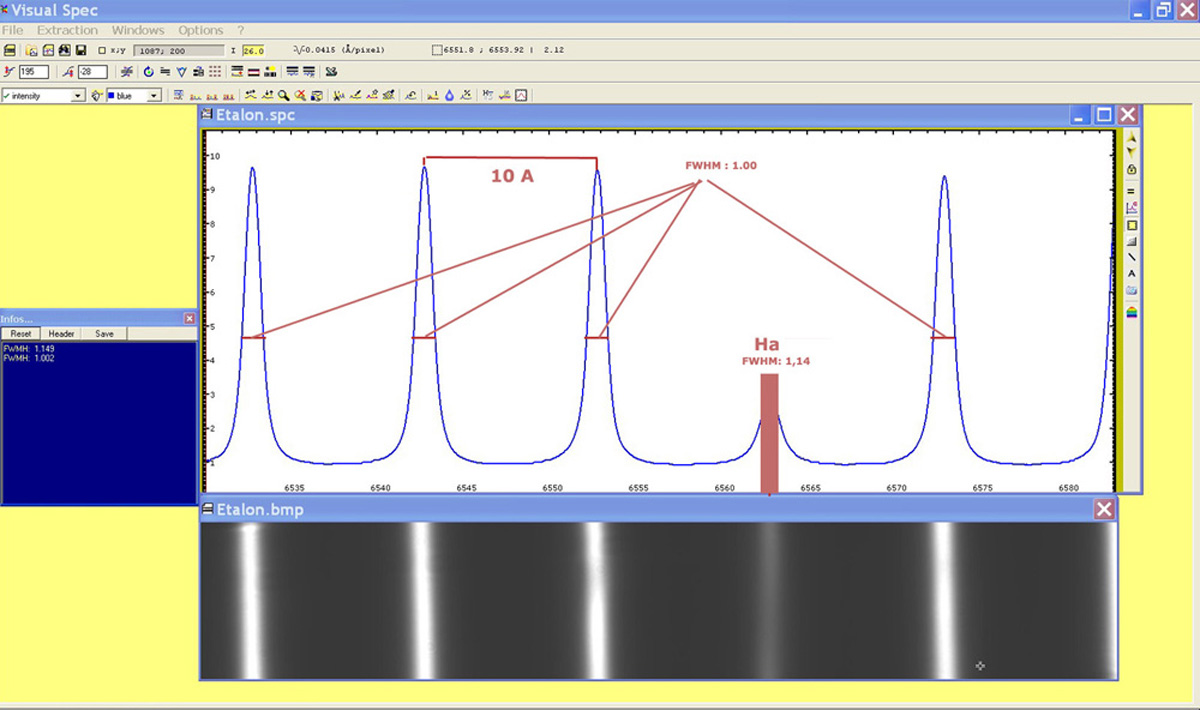
Le frange di diffrazione dell'etalon
Diffraction fringes of
Etalon

la banda passante del BF 5
BF 5 Bandpass
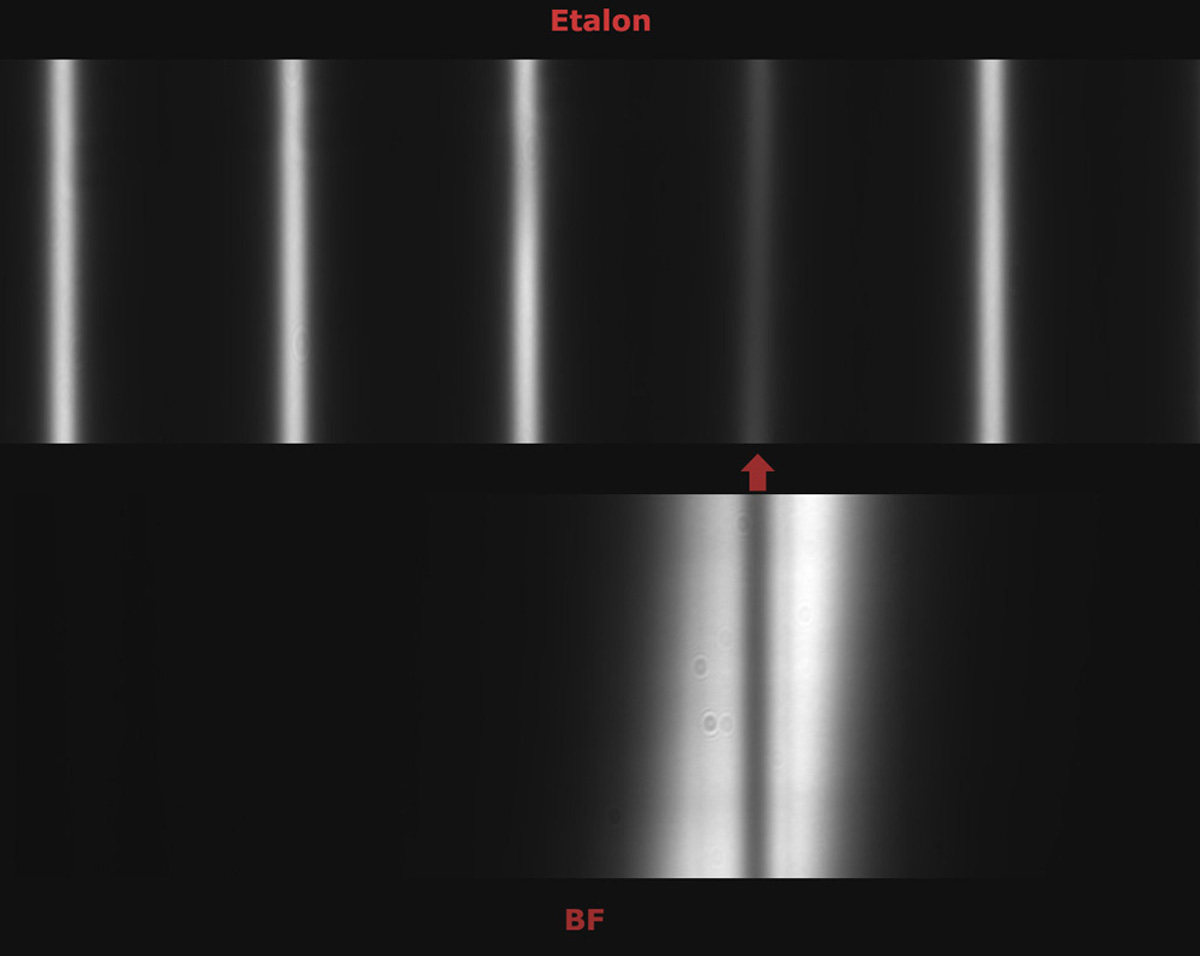
L'intersezione delle due bande, la cui coincidenza viene
ottenuta ruotando la ghiera di sintonia fine del PST
The intersection of two
bandpass, obtained by rotating th PST tune ring.
Modifiche al PST
PST modification
L'esperimento di modifica del PST in realtà è stato già
tentato da altri, in Francia ed in USA, ma io mi ripromettevo di apportare
ulteriori migliorie ai tentativi già effettuati, spesso con costosi apocromatici.Tanto
per cominciare, l'uso di obiettivi apo per una banda passate di 1 A nel rosso è
a mio avviso superflfluo, in quanto un buon acromatico che non abbia
sferocromatismo è più che sufficiente,In quest'ottica ho pensato di usare un
ottimo tubo ottico russo TAL con un obiettivo acromatico D 100 F 1000, per un duplice motivo:
1- Il rapporto F/D 10 è simile a quello di progetto del
PST, anche se, diaframmandolo col filtro anteriore esso si altera
2- Lo strumento era stato da me reintubato qualche tempo
fa in un tubo di alluminio da 750 mm di lunghezza complessiva (600 mm il tubo
nudo e 150 mm il fok alla escursione media) in modo da garantire un backfocus di 250 mm
circa, e tale soluzione si dimostrava ora particolarmente utile, dato che la
distanza tra Etalon e BF è particolarmente critica, e si aggira sui 200 mm,
variando poco in rapporto alla focale dell'obiettivo.
Le soluzioni possibili per il "trapianto" dell'etalon e
del BF del PST sull'acromatico erano essenzialmente due:
a) la prima, più facile, ottenibile ponendo il corpo del
PST (la parte nera con la cella zigrinata in gomma dell'etalon) dopo averlo
svitato dal tubo dorato con l'obiettivo,e dopo averlo dotato di un raccordo
maschio da 31,8 (o da 50,8, a seconda delle necessità) direttamente nel
portaoculari del focheggiatore del rifrattore, servendosi della messa a fuoco di quest'ultimo
per una prima focheggiatura di massima, e poi di quello del corpo del PST per
rifinirla,
effettuando infine, come di consueto il tuning dell'immagine sulla riga muovendo
la manopola zigrinata di gomma dell'etalon.Davanti all'obiettivo del rifrattore
TAL era stato applicato un filtro di
rigetto IR-UV ERF.In proposito
tengo a sottolineare che entrambe le modifiche che seguono vanno sempre ottenute dotando
l'ottica di un tale filtro , che non fa passare le radiazioni infrarosse e
ultraviolette, dannose per gli occhi.Le due immagini che seguono
sintetizzano la modifica in questione.
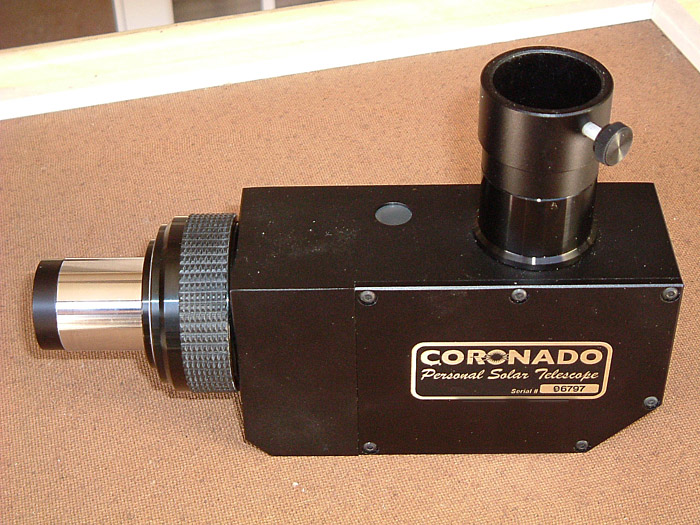
Corpo del PST smontato e dotato di un
raccordo da 31,8 mm
Coronado Body with a 31, 8
adaptor

Il corpo del PST applicato al rifrattore TAL
dotato di un filtro di rigetto IR-UV ERF Baader in una cella di pvc
autocostruita ( modifica A)
PST body at the TAL 100
focuser, in the A) type modification, with the ERF filter before the lens, in a
pvc self made cell.
b) Il secondo tipo di modifica consiste nel disassemblaggio sia dell'Etalon che del portaoculari col BF 5 e nel relativo
montaggio in una struttura che assicuri, come si è detto, una distanza reciproca
tra i due elementi di almeno 200 mm. circa,
con la possibilità, inoltre, di
poter variare in misura ridotta tale distanza, senz'altro critica ai fini
della visione dei particolari, in rapporto anche alla focale del telescopio
usato.Ho quindi montato i due elementi alle estremità di un focheggiatore da
31,8, che va a sua volta inserito tramite un raccordo da 31,8mm nel
focheggiatore principale del telescopio (nel mio caso quello del TAL) nel modo
visibile nell'immagine che segue:Tenuto conto che, probabilmente per le ridotte
dimensioni del BF in rapporto alla focale e per la presenza di un prisma di
vetro a ridosso del BF5 il sistema presentava dei riflessi interni, ho ritenuto
opportuno aggiungere, nell'adattatore da 31,8 un filtro Ha da 10 nm, con il
compito di ridurre al minimo la luce in ingresso nel sistema.Tali riflessi si
riducono comunque in modo notevole con l'uso di una barlow, dato il minore campo
inquadrato.La visione diretta della cromosfera con tale strumento così
modificato appare a mio avviso estremamente interessante , e notevolmente
superiore a quella ottenibile con lo strumento originario.
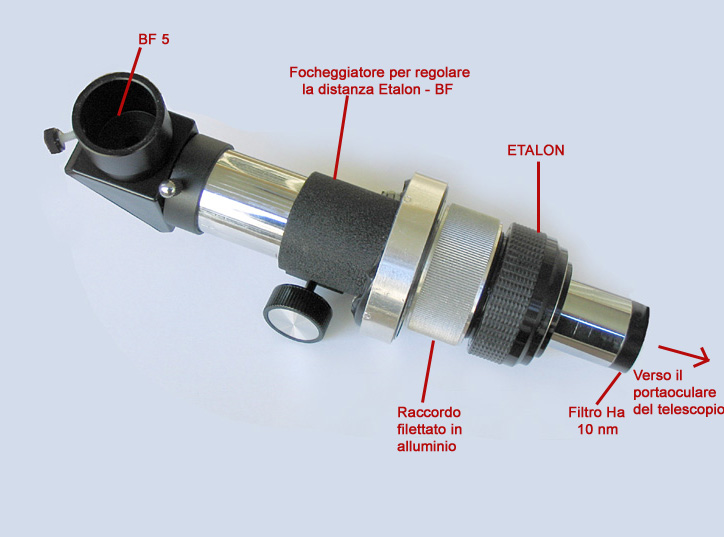
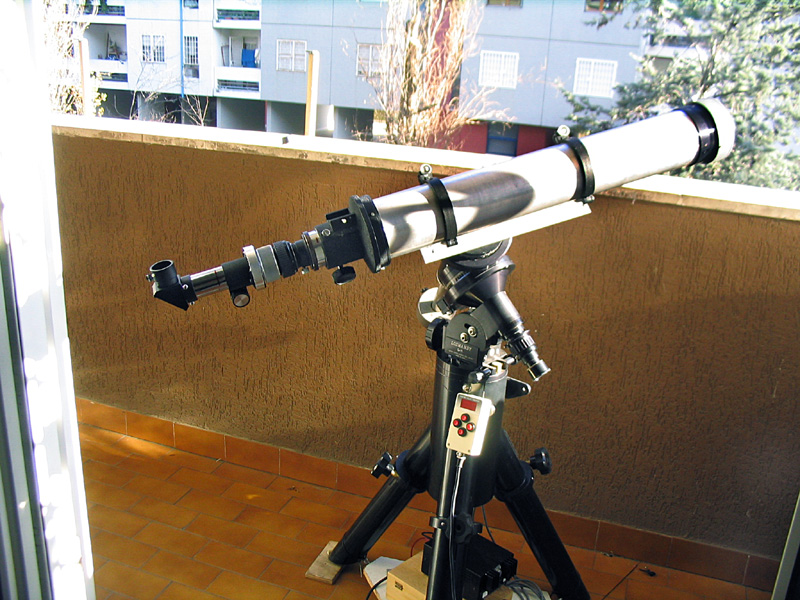
La seconda modifica (B)
effettuata, con l'etalon ed il BF5 montati su un focheggiatore da 31,8, e poi
l'intero sistema posto al fuoco del TAL 100R
The
second modification,B,with Etalon and BF mounted on a 31,8 focuser, and the
whole system inserted in the TAL 100 focuser
Dalle prove effettuate, mi è quindi sembrato
che la modifica di tipo B) fosse quella più perfomante, a parte il problema dei
riflessi, anche effettuando riprese con sensori CCD:le due immagini che seguono sono altrettanti esempi di quanto
ottenibile coi due tipi di modifiche:

Visibilità
della supergranulazione e di una piccola regione attiva sul disco solare con una
modifica di tipo A).C'è da dire comunque che l'immagine è stata ripresa in
inverno, con il sole molto basso sull'orizzonte; con una webcam Philips Toucam
pro BN e convertita in falsi colori.Barlow 2X per una EFL di 2000mm circa.
Sight of
supergranulation on the sun cromosphere with a type A mod, Philips Toucam camera
and barlow 2 X

Esempio di quanto ottenibile con la
modifica di tipo B).Immagine ripresa lo scorso 8 giugno 2009, quindi in
condizioni osservative abbastanza buone, con il sole a 60° circa sull'orizzonte
est, di una debole proturberanza ad arco.Media di due filmati di 1600 e 1300
frames , uno per la proturberanza, uno per il continuo,con una webcam Philips
Toucam BN assemblati e processati con PsP.
A recent
image on last june,8, 2009 of solar cromosphere with a beatiful arc prominence,
shot by the type B modded PST
E'
opportuno sottolineare, infine, che tale modifica viene effettuata a proprio
rischio, e che la alterazione od il disassemblaggio di strumenti ancora in
garanzia provoca la decadenza dalla garanzia stessa.
It's useful to underline that the above described
modifications are done at your own risk, and that, if done to an instrument
still under warranty, they may void the warranty itself
ADDENDUM
Una ripresa effettuata la mattina del 1° luglio 2009 ad una piccola
regione attiva del disco solare ha ulteriormente confermato l'ottima
resa della modifica di cui al punto 2), unitamente alle seguenti considerazioni:
1) un filtro Ha di quelli a banda stretta per Deep -Sky di banda passante
tra i 12 e 6 nm può migliorare anche sensibilmente la resa dell'immagine.Stavolta
il filtro Ha da 10 nm era stato avvitato direttamente al barilotto da 31,8 della
camera DMK ed inserito nel portaoculari con il BF5: probabilmente tale
soluzione ha contribuito alla eliminazione di riflessi spuri tra il BF ed il
prisma stellare da 31,8.
2) L'uso di una barlow 2X, eliminando quasi completamente la vignettatura
indotta dal BF5 (il cui diametro è insufficiente per la focale del sistema), da
il suo contributo al miglioramento della resa dell'immagine, al prezzo di un
minor angolo di campo,ma con il vantaggio di una migliore visione dei
particolari.
A shot on july, 1st 2009 to
a small active region on solar disk was a further confirmation of the two
following points:
1) An Ha filter for Deep Sky imaging,
say one of bandpass between 12 and 6 nm can improve the image.This time the
filter was attached to the threaded female 31,8 mm nose of the DMK camera and
inserted into the barrel with the BF 5.
2) The use of a 2X barlow virtually
eliminates the vignetting induced by the small diameter of BF 5 , considering
the EFL.The consequent smaller field of view increase noticeably the sun
granulation and other features visibility.
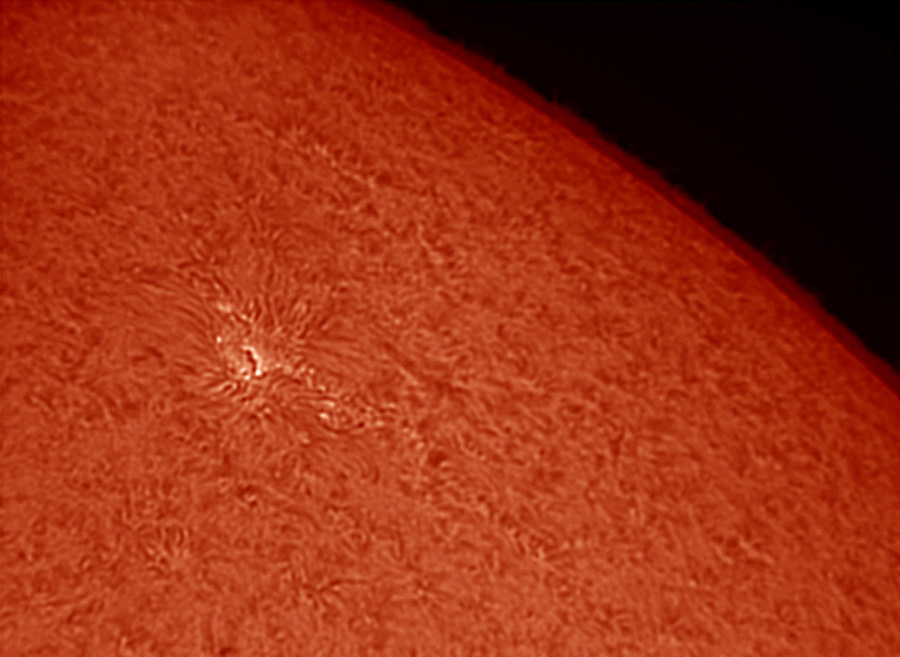
Media
di 9 immagini ottenute da altrettanti filmati AVI di 900 frames- barlow 2X-
Camera DMK 31 AF03 AS- Elaborazione Registax -Psp -falsi colori
Median of 9 images obtained by 9 AVI films, 900 frames
each -Camera DMK 31 AF03 AS -Processing Registax-Psp-false colors

Una
bella proturberanza catturata il 2 luglio 2009, h 7 UT, con lo
strumento portato a 3000 mm EFL tramite una barlow 3x, camera DMK 31 AF03 AS,
media di 900 frames di un filmato AVI per la proturberanza, e di altrettanti per
il disco da un altro filmato, processing con Registax 5 e Psp.
A
dramatic prominence captured on last July, 2, 2009 h. 7,00 UT, by the instrument
at 3000 mm EFL using a 3X barlow lens.Camera DMK 31 AF03 AS, median with
Registax 5 of 900 frames from an AVI film for prominence, and the same from
another film for the disk, assembled with Psp.
Osservazioni della
regione attiva AR 11024 effettuate il 5 luglio 2009 alle ore 7.00 TU alla focale
di 1000 e 3000 mm circa con una barlow TV 3X:
Observations of AR 11024 on last july, 5, 2009 h.7.00 UT, at 1000 mm EFL and
3000 mm

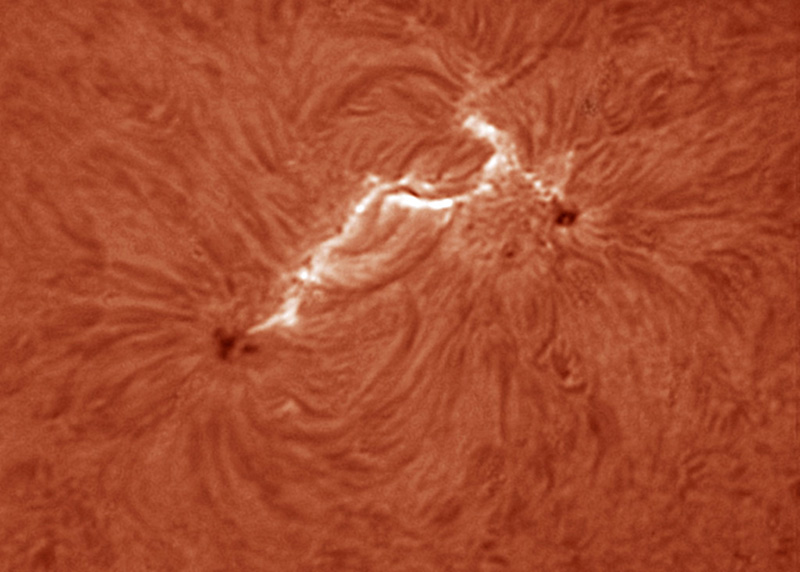
Due immagini della regione attiva 1057 del 1 aprile 2010, PST
modded+ barlow Ultima 2X + camera DMK (la seconda è in falsi colori)
Two recent images of active region 1057 on
april, 1, 2010: modded PST + barlow Ultima 2X + DMK BW camera (the second is in
false colours).

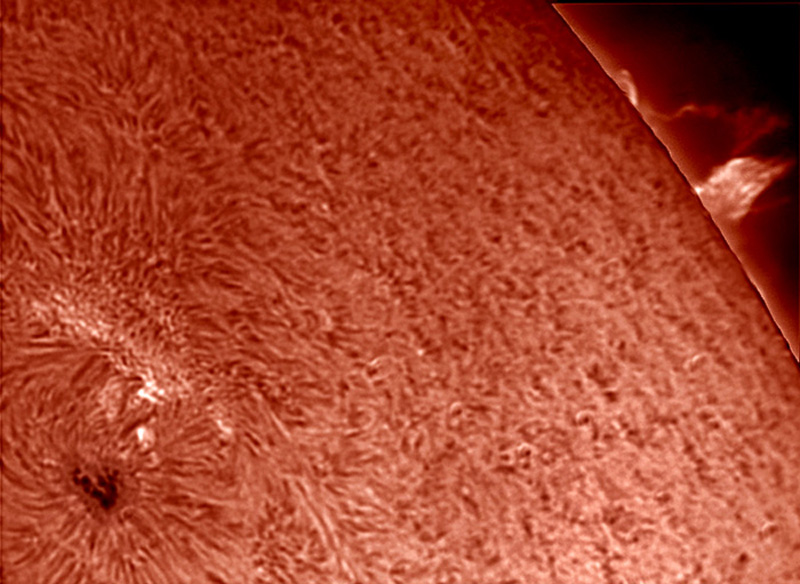
Una ulteriore modifica effettuabile con
poca spesa ed usando l'ERF da 70 mm.
A further unexpensive PST modification
with a 70 mm ERF
Tenuto conto dell'esiguità del diametro dell'ERF e di quello libero del
telescopio (70 mm)mi sono posto il problema di come incrementare il diametro
utile senza ulteriori spese aggiuntive quali quelle di un più costoso ERF da 90
o 110 mm.La risposta era semplice: bastava mettere il filtro lungo il cammino
ottico, anzichè davanti all'obiettivo; tuttavia tale soluzione mi sembrava non
ideale per il calore che inevitabilmente entrava nello strumento, suscettibile
di creare turbolenza,ma non c' era altra soluzione, così decisi di agire in tal
senso.Possedendo una cella di alluminio di diametro praticamente uguale a quello
interno del tubo del TAL, l'ho fatta adattare con modica spesa (20€) al filtro
da 70 mm (foto sotto).
A further unexpensive PST Modification was done
putting the 70 mm ERF filter previously used inside the Tal 100 tube.The filter
was adapted to an aluminum cell I owned and inserted into the tube, at a
distance of 25 cm from objective.It wasn't possible to go deeper for the
presence of the first field diaphragm, not ease to take off.Such a
distance, considering the filter as a diaphragm and an illuminated field at
focus of 5 mm (the one of Bf5),let to use a free aperture of 93 mm ,
considerably wider than before,

La cella col filtro è stata inserita
poi a pressione nel tubo ottico sino alla distanza di circa 25 cm
dall'obiettivo; oltre non è stato possibile andare per la presenza del primo
diaframma di campo di alluminio leggero, collegato agli altri diaframmi e quindi
non rientrabile senza dover modificare pesantemente il tubo.A tale distanza, considerando un
campo di piena luce al fuoco corrispondente al BF 5 , appunto di 5 mm,
l'apertura libera dello strumento risultava di 93 mm, quindi già una apertura
notevole.La visione dell'ERF attraverso l'obiettivo si presentava come nella
foto che segue.

La prima prova effettuata sul sole
con una camera ccd DMK è stata deludente, in quanto l'immagine era impastata e
sembrava confermare i miei timori sulla turbolenza strumentale.Anche stavolta Ho
inserito sul naso da 31,8 della camera un filtro Ha da 10 nm per deep sky, e
l'immagine è cambiata all'istante, divenendo molto buona e contrastata, con minuti
particolari visibili.Mi sono interrogato a lungo su tale situazione, e devo
confessare di non essere ancora riuscito a fondo a comprenderne il motivo.L'unica cosa
cui posso pensare è che il calore interno al tubo, anche se modesto e tutto
sommato irrilevante, provochi un leggero fuori banda dell'Etalon,
e che il filtro aggiuntivo intereagendo con la banda passante del BF metta le
cose a posto, ma è solo un'idea.E' certo, invece che anche con tale ulteriore
modifica i risultati
migliori, usando il BF5 originario del PST, si ottengono portando la focale a
2000 mm ed oltre, evitando in tal modo la vignettatura indotta dal ridotto
diametro del filtro e le zone di minor definizione.
Riassumendo , quindi:
1- ERF sul cammino ottico, purchè
posto a distanza non eccessiva dall'obiettivo (direi non oltre i 300-350 mm) per
non far aumentare oltre misura il calore che entra nello strumento ed arriva
sullo stesso ERF: sino a tali distanze l'incremento di calore può considerarsi
tutto sommato trascurabile
2- Uso di una buona barlow 2-3 x
3- Uso di un filtro interferenziale
Ha da 6 a 12 nm in uscita, prima della camera
Naturalmente il miglioramento sarebbe
molto più accentuato nel caso si usi un BF di maggior diametro:Sto infatti
studiando l'uso di un filtro Ha Baader da 1,5A come BF, ma la cosa è più
difficile del previsto per un fuori banda del filtro stesso che richiede un
sistema di tilting per funzionare correttamente.
In definitiva, questa ulteriore
modifica ha permesso di rendere più funzionale lo strumento, senza celle
aggiuntive davanti allo stesso, che ora sembra in tutto e per tutto un normale
rifrattore da 100mm, e di sfruttare quasi al massimo il suo potere risolutivo.
The first
attempt to use the device with a DMK BW ccd camera wasn't anyway satisfactory,
because the image was not crisp.Then , i tried to use a 10 nm Ha filter for deep
sky inserted in the 31,8 nose of camera, and all changed suddenly, the image
showed on the screen was full of contrast and crisp.Furthermore, the use of a 2X
barlow lens produced a much more corrected field of vue, without vignetting .To
get good results using the original BF5 is then necessary:
1- An ERF on
optical path, inserted not too far from objective (not over 300 -350 mm)
in order not to let heat enter the instrument (in the range of this setting the
heat is very low.
2- To use a
good 2-3X barlow lens
3- To use a
Ha 6-12 nm interference filter after the BF5, attached to the camera.
At last, this
further modification makes more functional the instrument, that now looks like a
normal 100 mm refractor, without external adjuntive cells, and let to
improve its resolving power, using quite the whole objective to image.
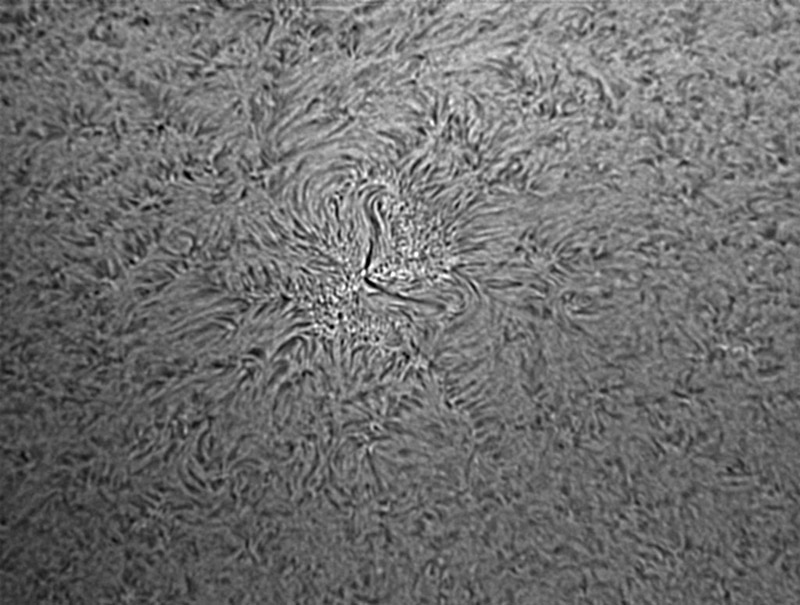
Un'immagine BN ottenuta col setup descritto
A BW image obtained with such a setup


Due immagini in falsi colori dell'AR 11084 ottenute il 27 e 28
giugno 2010
Two false colors images of AR 11084 on june, 27,28, 2010
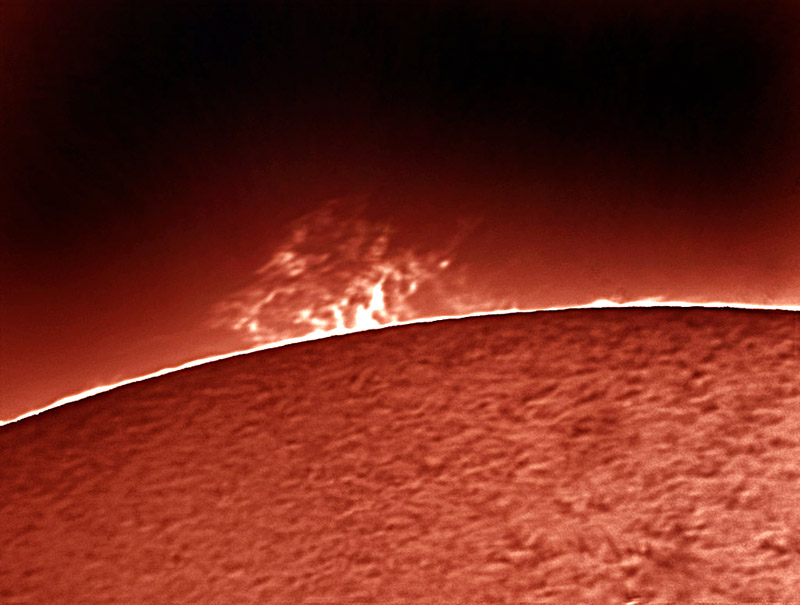
Una bella proturberanza del 28giugno 2010
A beautiful prominence of june, 28,2010

Un altra immagine del gruppo 11084 del 2 luglio 2010
Another image of sunspot group 11084 on july,
2, 2010

Una bella proturberanza di
marzo 2011
A
beautiful prominence on march, 2011

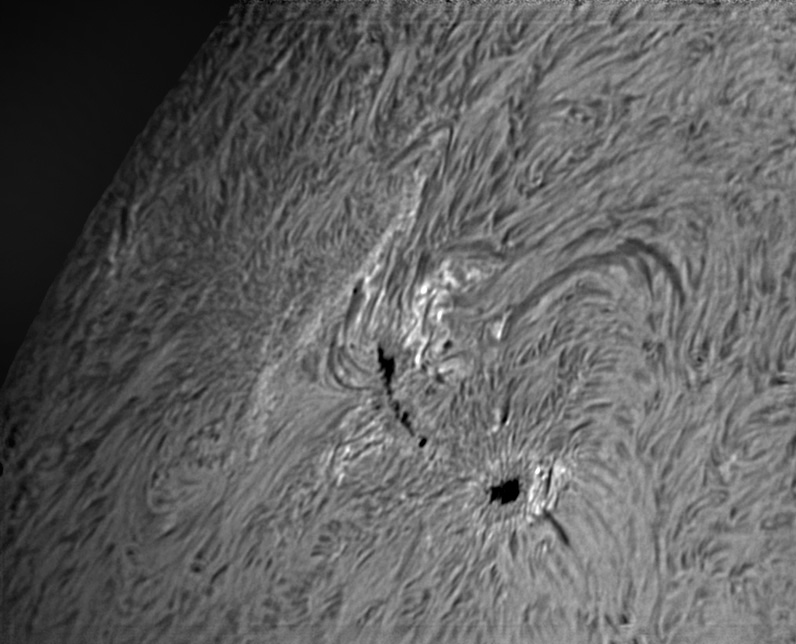
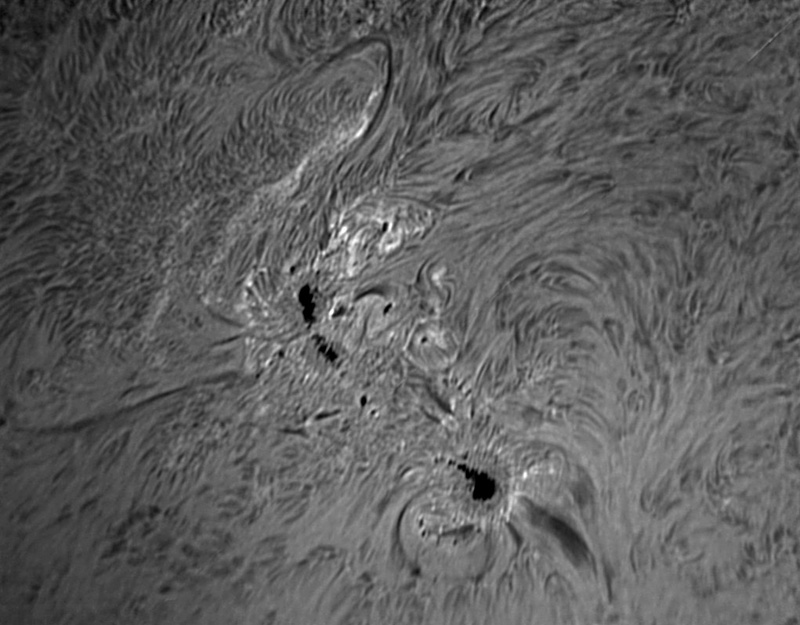
Una sequenza di riprese
effettuate il 24 e 25 marzo 2011, a focali diverse, dell'AR 1176 rispettivamente
a 1000 e 2000 di EFL.
A
sequence of images , on march 24 and 25 2011 of AR 1176, at EFL of
1000 and 2000 mm.

Un piccolo , ma
esteso flare nell'AR 1302 /2011
A small, wide flare in AR
1302/2011

Una bella
proturberanza ad albero
A beautiful tree prominence
NEW!
E, se non si usasse l'ERF?
And, if you don't use ERF?
Ho sostenuto in precedenza, ed a ragione, che
utilizzare l'Etalon ed il BF del PST senza l'obiettivo originale, in cui è incorporato (o
messo separatamente) un filtro di rigetto della radiazione UV-IR, è pericoloso,
per lo strumento e per la vista.Esiste tuttavia una possibilità secondaria per chi non
voglia sobbarcarsi la spesa dell'ERF, che per diametri elevati è notevole
(quello da 110 mm costa 475 €).Il
principio su cui si basa l'ERF è quello di ridurre la radiazione complessiva in ingresso nel
telescopio, da un lato, e dall'altro eliminare IR ed UV: ciò è evidente nel
grafico di trasmissione del Baader C-ERF sotto riportato, che una bandpass di
100 nm , trasmettendo la radiazione rossa tra 600 e 700 nm ed eliminando l'IR
nella parte 700-1450 nm.

Ma, a ben guardare, l'Astronomik R
per sintesi RGB (ed altri filtri simili) ha una banda passante pressocchè uguale, che va da 580 a 680 nm,
eliminando inoltre l'UV sino a 380 bm e l'IR sino a 900 nm.Esso è, inoltre,
estremamente diffuso e facile da reperire.Per essere sicuri del
filtraggio dell'IR oltre i 900 nm , è bene tuttavia usare un UV-IR cut accoppiato a detto filtro.

Ma,specie con l'uso di diametri elevati,,
o con l'uso di rapporti F/D inferiori a f 10
è opportuno anche ridurre il flusso di radiazione in arrivo sui predetti filtri
e l'etalon,quindi ho avuto l'idea di realizzare una sorta di aggiuntivo
da porre
dietro un rifrattore composto da :
-Un prisma di Herschel da 31, 8 (od anche da 50,8,
in tal caso tuttavia il costo dei filtri rosso e IR - UV cut sarebbe maggiore)
- Un filtro Rosso per RGB (Astronomik
od altro) , insieme ad un
IR_UV cut posti
prima dell'etalon
- l'etalon del PST con il Bf5,
come sopra, distanziati di circa 160 mm con tubi di prolunga
- un filtro Ha per Deep Sky sul naso da 31,8 della
camera, pur non essendo obbligatorio, migliora la qualità dell'immagine
come si vedrà in seguito
Il backfocus elevato derivante da tale soluzione
impone l'uso di un tubo corto rispetto alla focale dell'obiettivo (circa
600-630 mm compreso focuser a riposo per una focale di 1000, occorre tuttavia
fare delle prove ).
La mia esperienza di tale nuova soluzione può così
sintetizzarsi:
But,
with
the use of
big diameters,e/o
with
F
/
D ratio lower than 10,
is
also
appropriate to
reduce the flow of
incoming radiation
on these
filters
and
the
etalon,
then
I had the
idea to realize
a kind of
add-on
to be placed
behind
a refractor
composed of:
-A
Herschel wedge
from 31,
8 (or even
50.8)
-
A
Red
filter
for RGB
(Astronomik
or other),
together with a
IR_UV
cut
placed before
Etalon
-
The
etalon
of the
PST with
the
Bf5,
as above,
spaced approximately
160 mm
with extension tubes
-
The use of a H alpha
filter for Deep
Sky attached to the
camera nose, although not
mandatory,
improves the image
quality as you will
see below
The
high
backfocus
arising from such
solution requires
the use
of a
short tube
respect to the
lens focal length (approximately
600-630
mm inclusive of
focuser
at rest position
for
a focal length of
1000).
My experience
of this
new solution can
be summarized as follows
1)Strumentazione utilizzata
L'Aggiuntivo ottico in questione è formato, come
detto, in sequenza,da un prisma di Herschel Intes da 31,8 mm (che normalmente
uso per riprese solari con i rifrattori), da due filtri, rosso e Ir cut
Astronomik,dall'Etalon del PST, e, distanziato da circa 160 mm , dal BF 5 del
PST, nonchè dalla camera, una IS DMK 41 cui è stato applicato un filtro Ha da 10
nm per deep sky.Il rifrattore usato è stato un Vixen 90/1000 che uso per prove,
con l'ottica pesantemente danneggiata da una caduta e scheggiata in più parti ,
con le scheggiature ricoperte con onchiostro indelebile nero.La scelta è stata
dettata dalla necessità di dover tagliare il tubo per ottenere il backfocus
richiesto, e mi dispiaceva tagliare il tubo di uno strumento in ordine.Incredibilmente,
tuttavia, l'ottica ha sfoggiato prestazioni di tutto rispetto, nonostante lo
stato in cui si trova (meditino coloro che hanno paura che i granelli di polvere
pregiudichino le prestazioni di una buona ottica!).
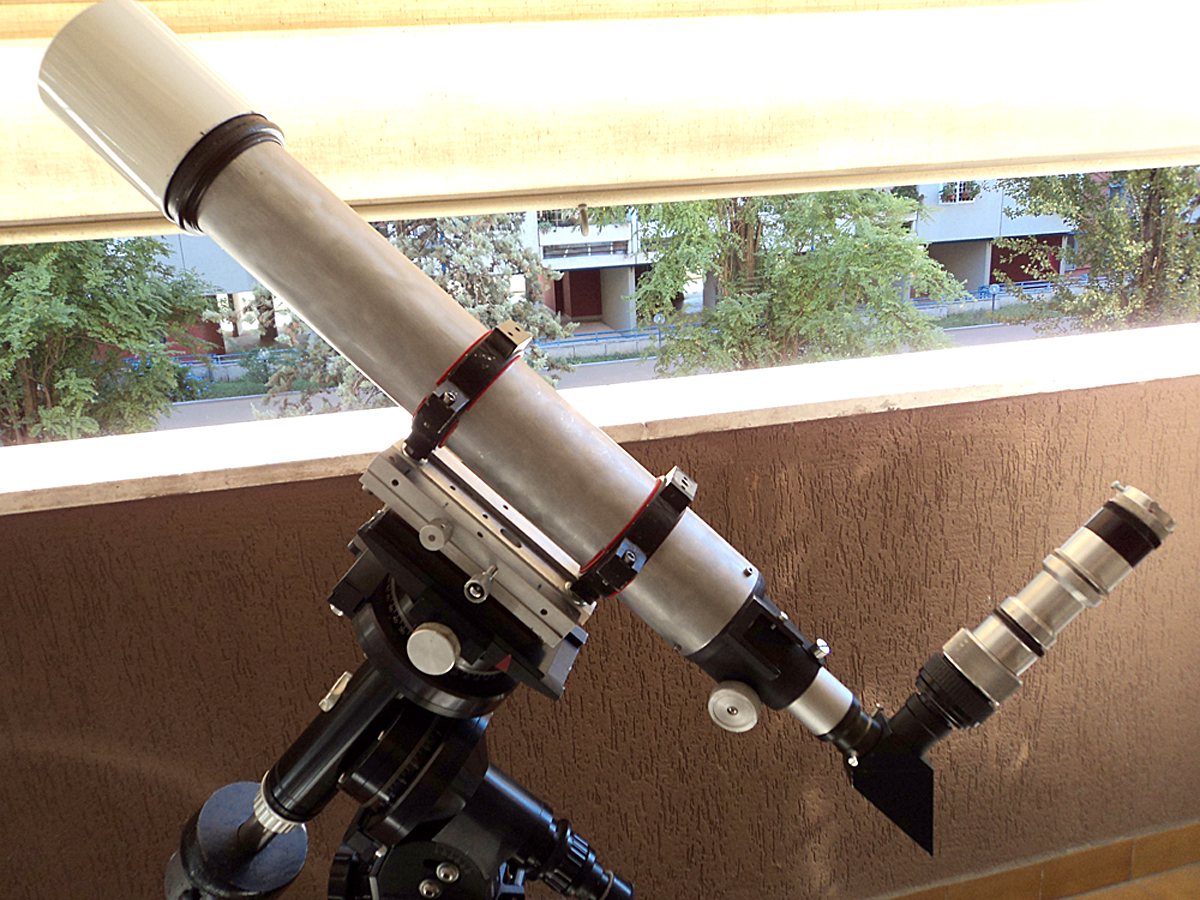
Il telescopio con l'aggiuntivo

L'accessorio in dettaglio
The device

L'obiettivo del telescopio usato per la
prova
The lens of the telescope
used for test
1^ prova del 26 agosto 2012
1 st test on august, 26, 2012
Alcune immagini sono state riprese coi soli
filtri Rosso-Ircut innanzi al l'Etalon, le altre con un Ha da 10 nm per deep Sky
marca Optometrics avvitato sul "naso" della camera.La differenza è notevole e
potrebbe spiegarsi solo con una interferenza tra BF e Ha che restringesse la
banda di quest'ultimo, aumentando il contrasto.Si nota la vignettatura
introdotta dal Bf di soli 5 mm, insufficienti rispetto alla focale di 1000 mm.

Le due immagini di cui sopra sono la media di 700
frames di due diversi filmati, mediati con Registax 5.Le modalità di stacking ed
elaborazione sono state identiche
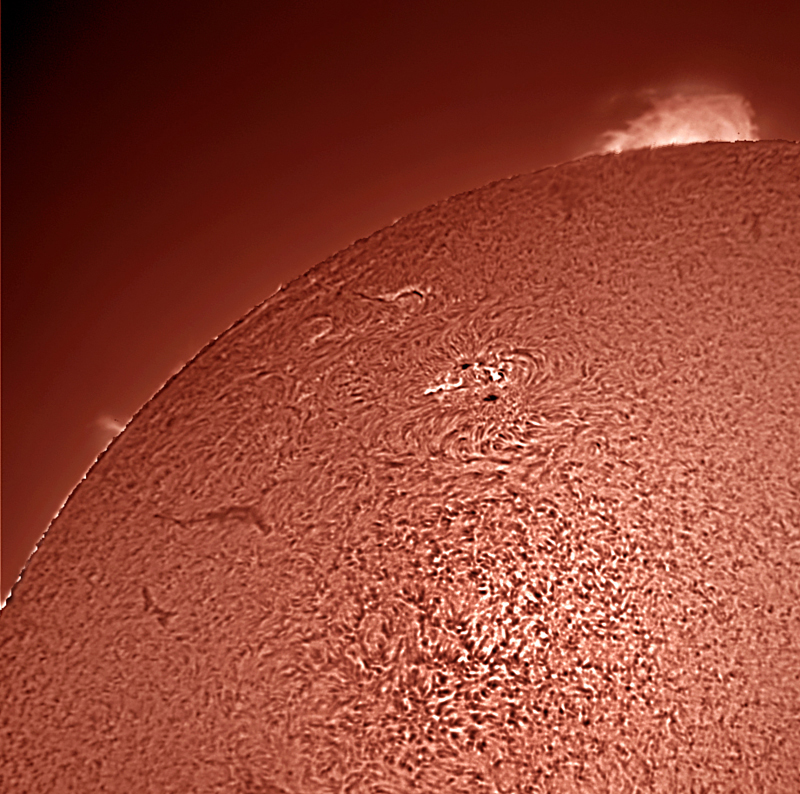
2^ prova del 29 agosto 2012
Nel secondo test del dispositivo ho provato ad inserire
nel portaoculari che alloggia il naso della camera un doppietto negativo di
potere 1,8 X circa, estratto a suo tempo da un vecchio 114/1000 made in Japan,
la cui qualità si è dimostrata insospettabilmente buona.Ciò per cercare di
limitare la vignettatura del BF 5.Naturalmente la focale viene quasi
raddoppiata, ma l'effetto di spianatura del campo c'è.Certo, sarebbe molto
meglio un BF 10 o 15, ma questi sono costosi, ed il mio fine è quello di
ottenere una modifica con un costo limitato.Si potrebbe obiettare che non tutti
possiedono un prisma di Herschel, ma tale accessorio è di estrema utilità per
l'osservazione in luce bianca.Nel mio dispositivo, quindi, togliendo la parte
contenente l'Etalon, i raccordi ed il BF del PST, e sostituendo il tutto con una
semplice prolunga con filtri Nd e Continuum, si può riprendere la stessa parte
del sole in luce bianca (od altro) con una qualità elevata.Naturalmente le prove
proseguiranno, anche per un ulteriore perfezionamento dell'idea.Nelle immagini
si nota un lieve sdoppiamento, dovuto probabilmente a riflessi tra elementi
ottici, da controllare e risolvere.
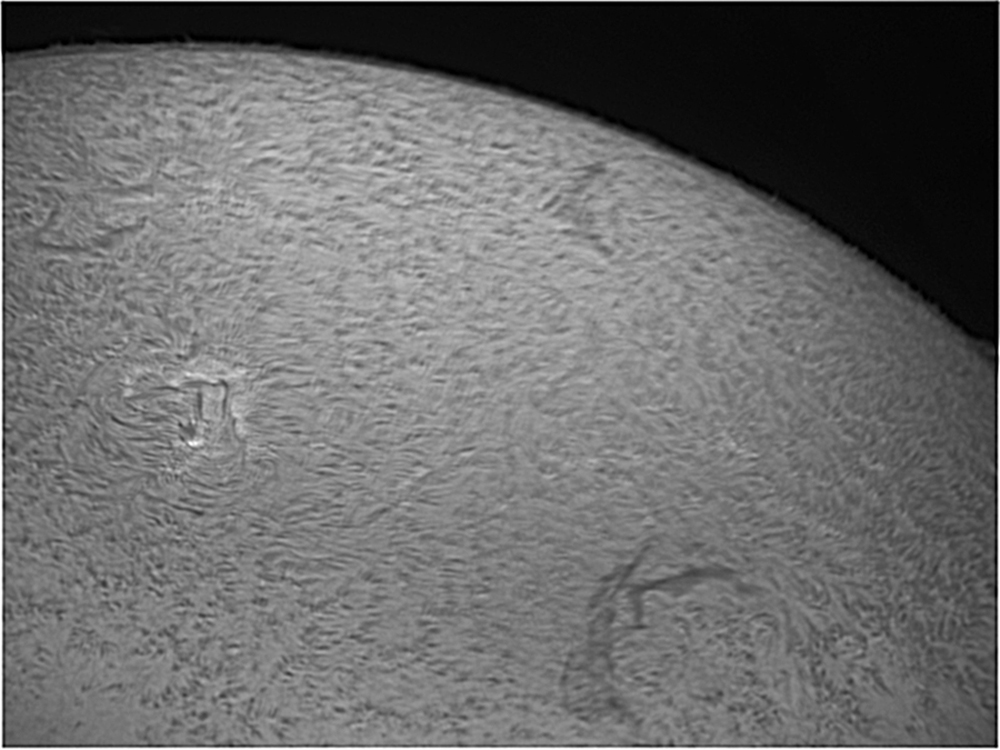
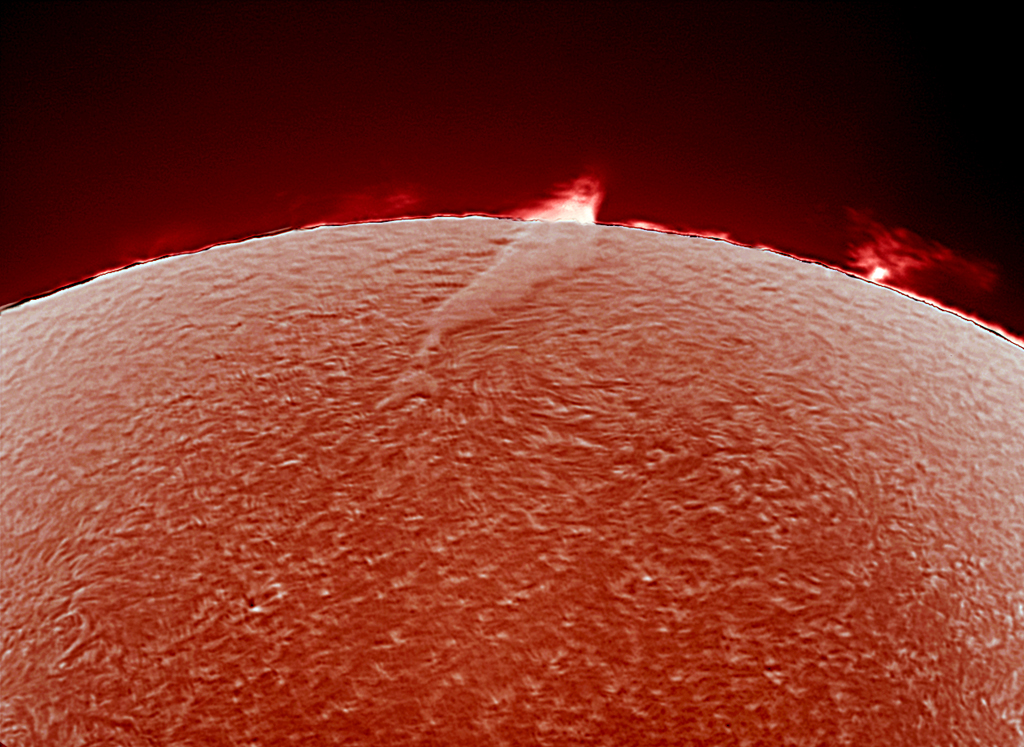
E
,ancora, se non si usasse l'ERF,
e si mantenesse il tubo originale del telescopio?
And,yet, if you don't use ERF ERF and don't want
want to modify the telescope tube ?
In tal caso la scelta obbligata è porre una barlow di
potere 2X prima del prisma di Herschel
(possibilmente avvitata sul maschio da 31,8 di questi), ma in tal caso, in via
teorica, le alternative sono due:
1- La barlow assorbirebbe una buona parte di calore e
raggi UV non filtrati, per cui correrebbe rischi di rottura ; sarebbe quindi
opportuno usare una barlow di poco prezzo e qualità, ma con possibili riflessi
sulla incisione dell'immagine.
2- Si potrebbero porre prima della barlow
(possibilmente attaccati a questa) i filtri rosso e UV-IR cut , i modo da
ridurre di molto, se non evitare il rischio di una sua rottura; in tal modo
tuttavia il rischio di rottura si trasferirebbe sui filtri, con un possibile
costo ancora maggiore.
In entrambi i casi si necessiterebbe di un
focheggiatore a corsa molto lunga per compensare l'allungamento del backfocus
indotto dalla barlow (il focheggiatore del mio TMB è stato estratto di 11 cm
circa).
Fin qui l'idea teorica.Il test pratico, effettuato col
mio TMB LZO 115/7 nei primi giorni di settembre 2012, ha dato i seguenti
risultati:
3^ Prova del 9 settembre 2012
1-La barlow, un'ottica da battaglia pagata 20€ e quindi
sacrificabile,è stata avvitata sul naso da 31,8 del prisma di Herschel Intes, e
quindi posta a circa 100 mm dal punto di fuoco senza alcuna protezione.Ebbene,
con mia grande meraviglia, dopo 45 minuti continui di osservazione, il barilotto
ed il vetro erano appena tiepidi (non più di 2-3 gradi di aumento di temperatura
stimati) sicuramente molto meno della camera DMK esposta al Sole, la cui parte
esterna scottava quasi.

La Barlow

Il TMB 115/800 con l'aggiuntivo PST
2- L'immagine risultante risentiva della vignettatura
indotta dal BF 5, quindi ho tentato direttamente di eliminarla con un altra
barlow (più precisamente un estrattore di fuoco di potere 1,8 X, lo stesso usato
in precedenza), inserita nel barilotto del BF5, prima della camera: sulla camera
stessa è stato avvitato un filtro UV_IR cut Baader.La focale risultante è stata
quindi di 800 x 2 x 1,8= 2880 mm teorici , tuttavia, essendo la barlow inserita
prima del deviatore nel percorso ottico e più vicina all'obiettivo è lecito
pensare che la EFL abbia superato di parecchio i 3 metri.La qualità complessiva
dell'immagine si è dimostrata abbastanza buona, considerato il seeing non eccellente e le
barlow di scarsa qualità usate, come si osserva dalle immagini che seguono.Sicuramente
risultati migliori potranno ottenersi con una Barlow di buona qualità in
ingresso e, date le premesse, penso si possa fare.Preciso che le immagini
originali , elaborate con Psp, sono state ulteriormente processate con una
deconvoluzione RL in Astroart per aumentare il contrasto e la visibilità dei
particolari.Notevole l'apparenza delle fibrille e della sorta di granulazione
intorno alla regione attiva della seconda immagine.Data la focale elevata,
l'immagine è scura e granulosa e quindi tale modifica NON è indicata
per l'uso visuale.Inutile dire che penso ci siano ulteriori margini di
miglioramento, e che cercherò di ottenerli: quello più ovvio e facile sarebbe
quello di usare un BF più grande (10-15 mm) ma tale dispositivo costa, e la mia
filosofia è quella di mantenere nei limiti del possibile il costo dello
strumento originario.








































